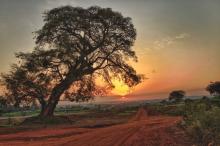GBM Blog
Queen of Africa’s Trees: The Sacred Fig Tree
This blog was written by communications intern Tim Webster.
“In Africa, there lives an extraordinary tree. She is queen of the riverbank. A monarch, whose story stretches back millions of years. In tribal cultures, her mysterious ways have fuelled myth and legend. They set her apart from other trees. She is a Sycamore Fig, Queen of Africa’s trees.”
The above quote, taken from the 2005 award-winning film, ‘Queen of Trees’, depicts the mythology surrounding the Sycamore Fig Tree, a tree native to Central Africa. Kenyan folklore and the traditional narratives of the Kikuyu people, the largest ethnic group in Kenya, have long revered and worshipped the Fig Tree as sacred. Professor Wangari Maathai, founder of the Green Belt Movement, advocated the importance of the Fig Tree’s presence on the entire ecosystem and the people who depend on the soil and water to live.
 In Kenya, beneath the fig trees’ leafy branches, Kikuyu men still pray for riches and for the blessing of rain, without which their crops will not grow, nor will there be fresh green grass for their cattle and sheep. To ensure pregnancy Kikuyu women smear themselves with the milky juice of the tree and pray beneath the tree that they may bear offspring. The fat of cattle, sheep and goats is mixed with the milk of the tree to increase fertility. Men also gather the leaves of the tree and sleep upon them, in the belief that the fertility will pass from the leaves to themselves and from themselves to their flocks.
In Kenya, beneath the fig trees’ leafy branches, Kikuyu men still pray for riches and for the blessing of rain, without which their crops will not grow, nor will there be fresh green grass for their cattle and sheep. To ensure pregnancy Kikuyu women smear themselves with the milky juice of the tree and pray beneath the tree that they may bear offspring. The fat of cattle, sheep and goats is mixed with the milk of the tree to increase fertility. Men also gather the leaves of the tree and sleep upon them, in the belief that the fertility will pass from the leaves to themselves and from themselves to their flocks.
The Fig Tree not only binds communities through these shared beliefs, or ‘eco-spiritualism’ as it has been labelled, but practically upholds the land against environmental degradation. With its deep roots descending into the underground rock, the tree provides protection to the people by stabilising the soil from landslides in the steep highlands. The roots also bring the subterranean water system closer to the surface, forming streams.
Professor Maathai’s work and the work of the Green Belt Movement are to re-establish trees indigenous to Africa, such as the Sycamore Fig tree in order to restore the forest cover and watersheds, and with it the natural ecosystem. As Professor Maathai maintained, the importance of these trees should not be underestimated nor forgotten, and to protect future generations we would do well to heed the wisdom of previous ones.
Photo credit: www.ikamegi.org
